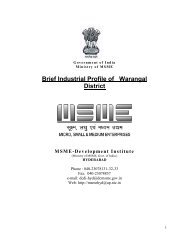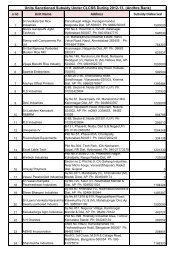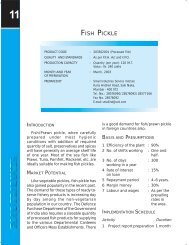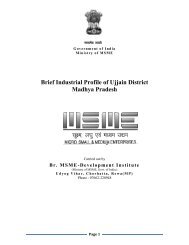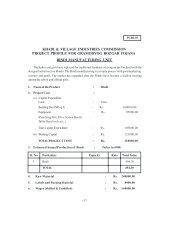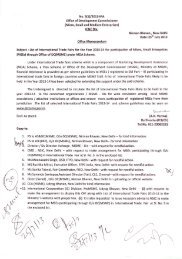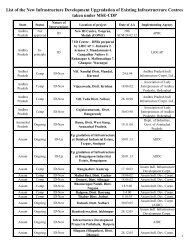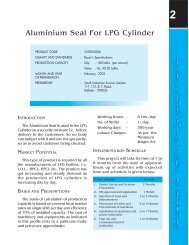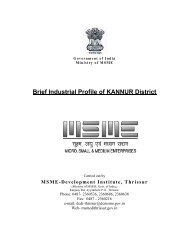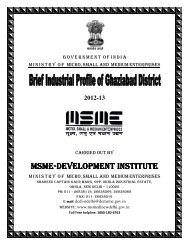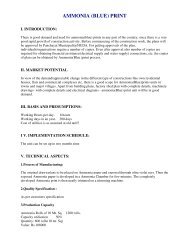TENNIS BALL - Dc Msme
TENNIS BALL - Dc Msme
TENNIS BALL - Dc Msme
Create successful ePaper yourself
Turn your PDF publications into a flip-book with our unique Google optimized e-Paper software.
A<br />
PROJECT PROFILE<br />
ON<br />
<strong>TENNIS</strong> <strong>BALL</strong><br />
2011-2012<br />
Prepared by<br />
MSME DEVELOPMENT INSTITUTE,<br />
Ministry Of MSME<br />
Govt. of India<br />
34, Industrial Estate, Nunhai<br />
Agra‐282006 (U. P )<br />
Phone : 91‐562‐2280879 Telefax : 91‐562‐2280882<br />
E-mail dcdi-agra@dcmsme.gov.in Website: www.msmediagra.gov.in<br />
1
PROJECT PROFILE ON <strong>TENNIS</strong> <strong>BALL</strong><br />
PRODUCT CODE : NIC 2004: 36934<br />
ASICC: 93114<br />
QUALITY STANDARD : IS: 2216-19885 Or International Standards<br />
PRODUCTION CAPACITY (PA) :<br />
QUANTITY : Tennis Ball 6,00,000 Balls PA<br />
VALUE : Rs. 90,00,000/- PA<br />
YEAR OF PREPARATION : 2011-12<br />
PREPARED BY : Leather Division<br />
MSME Development Institute<br />
34, Industrial Estate, Nunhai,<br />
Agra-282006<br />
Ph: 2280879, Fax (0562) 2280882<br />
E-MAIL– dcdi-agra@dcmsme.gov.in<br />
***********************************************************************************<br />
(I)<br />
INTRODUCTION<br />
Tennis is a four-point game played on a court and which is divided in the middle by a<br />
net. For playing this game, a ball is hit by players (two or four) on both sides in such a way that it goes<br />
to others side without touching the net and falls in the specified marked area of the court. This ball is<br />
known as Tennis Ball. These balls are made of vulcunised rubber and covered with Melton cloth, which<br />
has high wool content or Needle cloth, which is cheaper to produce and can have a greater content of<br />
synthetic fibres. It is available in white or optic yellow.<br />
(II) MARKET POTENTIAL<br />
Tennis is an internationally popular game. It is played in many countries of world. It is<br />
becoming in very popular in India also as amount of Award is huge in most of the events. India is also<br />
holding international events for this game, which has popularised this game and many international<br />
stars have come up from India also. This has increased the demand of tennis balls in domestic market.<br />
In international also, Indian balls have very good demand.<br />
(III) SCOPE<br />
This industry is a non-polluting and labour intensive industry. Therefore, it has<br />
tremendous scope and this type of units can be started anywhere in rural or urban area.<br />
( IV ) BASIS & PRESUMPTION<br />
1. The capacity is based upon monthly production 50,000 Tennis Balls on Single Shift of 8-hrs.<br />
a day and 25-working days in a month.<br />
2. It is presumed that Ist year, the capacity utilization will be 70% followed by 85% in the next<br />
year and 100% in the subsequent year.<br />
3. The rates quoted in respect of salaries and wages for skilled worker and others are on the<br />
basis of minimum rate in the state of U.P.<br />
4. Interest rate for the fixed and working capital has been taken @ 14% on an average whether<br />
financed by the Bankers or Financial Institutional.<br />
2
5. The margin money required is minimum (25% of the total capital investment).<br />
6. Pay –Back period may be five year after the initial gestation period.<br />
7. The gestation period in implementation of the project may be to the tune of 6 to 9 months<br />
which includes making all arrangements completion of all formalities, market surveys and<br />
tie-ups etc.<br />
8. The Break even point of the scheme has been calculated on full capacity utilization basis.<br />
considering 3 months working capital.<br />
9. Capacity may be achieved at the end of three years.<br />
(V). IMPLEMENTATION SCHEDULE:<br />
The implementation of the project includes various jobs/ exercised such as procurement<br />
of technical know how transfer of technology market survey and tie ups preparation of project report<br />
selection of sitter, registration financing of project procurement of machinery and raw materials etc.<br />
recruitment of staff creation/commissioning of machines trial production and commercial production<br />
etc.<br />
(VI) PRODUCTION DETAIL AND PROCESS OF MANUFACTURE:-<br />
The manufacturing of Tennis Balls involves various processes. First of all a solution is<br />
prepared by thoroughly masticating (kneading) rubber with variety of powders to give the required<br />
properties, e.g. strength, colour, and to enable it to cure and to make it softer to work and to ensure that<br />
subsequently the solution will flow correctly. The solution of this rubber compound is prepared with<br />
petroleum solvent. Then a formulation of rubber compound is prepared which contains Natural rubber,<br />
General purpose furnace' (GPF) black (a reinforcing filler), Clay, Zinc oxide, Sulphur,<br />
Diphenylguanidine (DPG) (an accelerator for the curative system), Cyclohexyl benthiazyl<br />
sulphenamide (HBS) (also an accelerator). This compound is then extruded to produce pallets. The<br />
pellets are loaded into a hydraulic press which forms them into hemispherical 'half-shells' and partially<br />
cures them, typically for 2 ½ min at 150º. The half-shells are removed from the press, joined together<br />
in a sheet by the 'flash', which has spread out of the moulds during the forming. The flash is removed<br />
by a hydraulic press fitted with cutting knives, which remove the half-shells from the sheet. The edge<br />
of the half shell is roughened (or buffed) with a grinding wheel to provide a key for the adhesive which<br />
is next applied. A vulcanising rubber solution is applied to the edge of the buffed half shell. For<br />
inflation of the ball, inflation chemicals like sodium nitrate and ammonium chloride are used which<br />
produce nitrogen during the moulding process. These cores are then cured in moulds. The core is then<br />
buffed to provide a rough surface to act as a key for the solution which is applied next. The cores are<br />
then coated with uniform layer of rubber solution. These coated cores are then covered with Melton<br />
cloth or Needle cloth. The balls are then placed in a moulding press and heated, curing together the<br />
rubber solution on the core and that on the back of the cloth. Finally, Tumbling the balls slowly<br />
through a steam laden atmosphere causes the cloth to fluff, giving a raised and softer surface and the<br />
ridge around the ball also disappears. The balls are then tested and graded brand name is marked.<br />
( VII ) QUALITY CONTROL AND STANDARD:<br />
The balls can be produced as per international standards or Indian Standards IS: 2216-<br />
19885. However, following parameters are very important for a Tennis Ball<br />
Dimensions- The balls shall be of diameter 63.5 to 66.7 mm.<br />
Mass- The mass of the balls shall be between 56.7 and 58.5 g.<br />
Requirements- The ball shall have a uniform outer surface and shall be white or yellow<br />
in colour. If there are any seams, they shall be stitchless.<br />
3
Bounce- The ball shall have a bounce of not less than 135 cm and not more than 147 cm<br />
when dropped from a height of 254 cm upon a 1:3:6 concrete base of 76 mm thickness.<br />
Deformation- The ball shall have a forward deformation of more than 5.6 mm and less<br />
than 7.4 mm and return deformation of more than 8.9 mm and less than 10.8 mm at 8.165 kg load. The<br />
two deformation figures shall be the averages of three individual readings along three axis of the ball<br />
and no two individual readings shall differ by more than 0.8 mm in each case.<br />
(VIII) PRODUCTION CAPACITY (PER ANNUM)<br />
ITEM QUANTITY VALUE<br />
Tennis Ball 6,00,000 Balls 90,00,000 (@ Rs. 15/- each ball)<br />
( @2000 balls per day,<br />
25 days a month)<br />
(IX)<br />
POWER REQUIREMENT:<br />
Electricity Load Required<br />
15 KW<br />
( X ) FINANCIAL ASPECTS:<br />
1. Fixed Capital<br />
(A)<br />
LAND & BUILDING:<br />
Rented Premises 2000 Sq ft<br />
( B ) MACHINS & EQUIPMENTS:<br />
Rs. 10,000/- PM<br />
S.No. Description Nos. Ind/Imp Total Value<br />
(Rs.)<br />
1. Two Roll Mixing Mill 10”X24” 1 Ind 350000.00<br />
2. Hydraulic Compression Moulding Press 1 Ind 250000.00<br />
(Two daylight) – 18”X18”<br />
3. Motor & Starter 2 Ind 25,000.00<br />
4. Half Cup moulding Die (16 cups) 2 Ind 20000.00<br />
5. Full Ball Curing Die (16 Balls) 2 Ind 30000.00<br />
6. Felt Dumbbell Cutting Press 1 Ind 5000.00<br />
7. Bare Ball Abrading Drum with motor 1 Ind 10000.00<br />
8. Cup Edges abrading Stone with motor 1 Ind 7500.00<br />
6. Tools and Equipments 10,000.00<br />
7. Furniture and office equipments 50,000.00<br />
8. Generator 1 Ind 20,000.00<br />
9. Installation and electrification charges 20,000.00<br />
TOTAL 7,97,500.00<br />
(C)<br />
PRE OPERATIVE EXPENSES:<br />
Pre operative Expenses 20,000.00<br />
Total Fixed Capital (A+B+C) : Rs. 8,17,500.00<br />
4
2. Working Capital<br />
(i)<br />
Staff and Labor (per month):-<br />
S.No. Description No. Salary @ Total Value (Rs.)<br />
i) Director/Properitor 1 10,000 10,000.00<br />
ii) Supervisor 1 6,000 6,000.00<br />
iii) Clerk cum Cashier 1 5,000 5000.00<br />
iv) Skilled Workers 2 5,000 10,000.00<br />
v) Semi skilled worker 2 3,500 7,000.00<br />
vi) Helpers 4 3,500 14,000.00<br />
vii) Sweeper (Part Time) 1 1,000 1,000.00<br />
ix) Watchman 2 3,500 7,000.00<br />
Total 60,000.00<br />
Add 20 % Perquisites 12,000.00<br />
Total 72,000.00<br />
(ii)<br />
Raw Material (per month):-<br />
S.No. Description Qty. Rate(Rs.) Value (Rs.)<br />
i). Natural Rubber 2500 kg 200 5,00,000.00<br />
ii). CaCO3 2500kg 10 25000.00<br />
iii) Pigment 10 kg 350 3500.00<br />
iv) Sulfur 75kg 15 1125.00<br />
v) Accelerators 25kg 350 8750.00<br />
vi) Other Additives 5000.00<br />
Total Rs. 5,43,375.00<br />
(iii) UTILITIES (p.m.)<br />
i) Power 10,000.00<br />
ii) Fuel 1,000.00<br />
iii) Water 500.00<br />
Tota Rs. 11,500.00<br />
(iv) OTHER EXPENSES (P.M.)<br />
i) Postage and Telephones 1,000.00<br />
ii) Transport 2,000.00<br />
iii) Consumable store 500.00<br />
iv) Sales Expenses 2,000.00<br />
v) Entertainment 1,000.00<br />
vi) Insurance 1,000.00<br />
vi) Other Contingencies 2,500.00<br />
Total Rs. 10,000.00<br />
(v)<br />
WORKING CAPITAL (PER MONTH)<br />
i) Salaries and wages 72,000.00<br />
ii) Raw Material and chemicals 5,43,375.00<br />
iii) Utilities 11,500.00<br />
iv) Rent 10,000.00<br />
iv) Other Expenses 10,000.00<br />
Total Rs 6,46,875.00<br />
5
(vi) WORKING CAPITAL ( FOR THREE MONTHS ) :-<br />
Rs. 6,46,875X3 = 19,40,625.00<br />
(vii)<br />
TOTAL CAPITAL INVESTMENT:-<br />
Fixed capital: 8,17,500.00<br />
Working capital for 3 months: 19,40,625.00<br />
Total Rs 27,58,125.00<br />
Say Rs 27,58,000.00<br />
(viii) COST OF PRODUCTION (PER ANNUM):-<br />
(a) Total Recurring expenditure 77,62,500.00<br />
(b) Depreciation on Machinery @ 10% 73,750.00<br />
(c) Depreciation on Tools and Equipments @20% 2,000.00<br />
(d) Depreciation on office euip. and Furniture etc. @ 20% 10,000.00<br />
(e) Interest on Total Capital Investment @ 14% 3,83,180.00<br />
Total: 82,31,430.00<br />
Say: Rs 82,31,000.00<br />
(ix)<br />
TOTAL SALES ( PER ANNUM):-<br />
Sl. No. Item Rate per pc. Value (Rs.)<br />
1. 6,00,000 Tennis Balls 15/- 90,00,000.00<br />
(x)<br />
(xi)<br />
PROFITABILITY( Per Annum):-<br />
NET PROFIT RATIO:-<br />
Sales - Cost of Production<br />
90,00,000 – 82,31,000= Rs 7,69,000<br />
Profit x 100<br />
Sales per Annum<br />
7,69,000X 100<br />
90,00,000<br />
= 8.54 %<br />
(xii)<br />
RATE OF RETURN:-<br />
Profit x 100<br />
Total investment<br />
7,69,000X 100<br />
27,58,000<br />
= 27.88%<br />
(XIII) BREAK EVEN POINT: -<br />
Fixed Cost (per annum)<br />
(a) 40 % of Salaries 3,45,600.00<br />
(b) 40 % of Utilities 55,200.00<br />
(c) 40 % of other expenses 48,000.00<br />
(c) Depreciation 85,750.00<br />
(d) Rent 1,20,000.00<br />
(d) Interest on total capital Investment 3,83,180.00<br />
Total Rs 10,37,730.00<br />
6
Break Even Point = Fixed Cost x 100<br />
Fixed cost + profit per year.<br />
= 10,37,730 X 100<br />
10,37,730 + 7,69,000<br />
57.43%<br />
(XIV) LIST OF MACHINERYAND RAW MATERIAL SUPPLIERS<br />
1. Bharaj Machineries Pvt. Ltd.<br />
Plot No. 12 & 13, Survey No 66, Hissa No. 1/1,<br />
Naik Pada, Village-Waliv, Taluka: Vasai (East)<br />
2. Premier Engineers<br />
Post Box No. 11, Opp. Rly. Microwave Tower,<br />
Sirhind - 140406, Punjab, India<br />
3. JRD Rubber & Plastic Technology Pvt. Ltd.<br />
K-49, Model Town II, Delhi - 110009, India<br />
4. Santec Group<br />
Plot No. 92/6, Road No. 4, Mundka Udyog Nagar,<br />
Mundka Extension, Delhi - 110041, India<br />
5. Uttam Rubber Machinery (P) Ltd.<br />
B-61/3, Maya Puri Indl. Area, Phase II<br />
New Delhi - 110064, (INDIA)<br />
7




